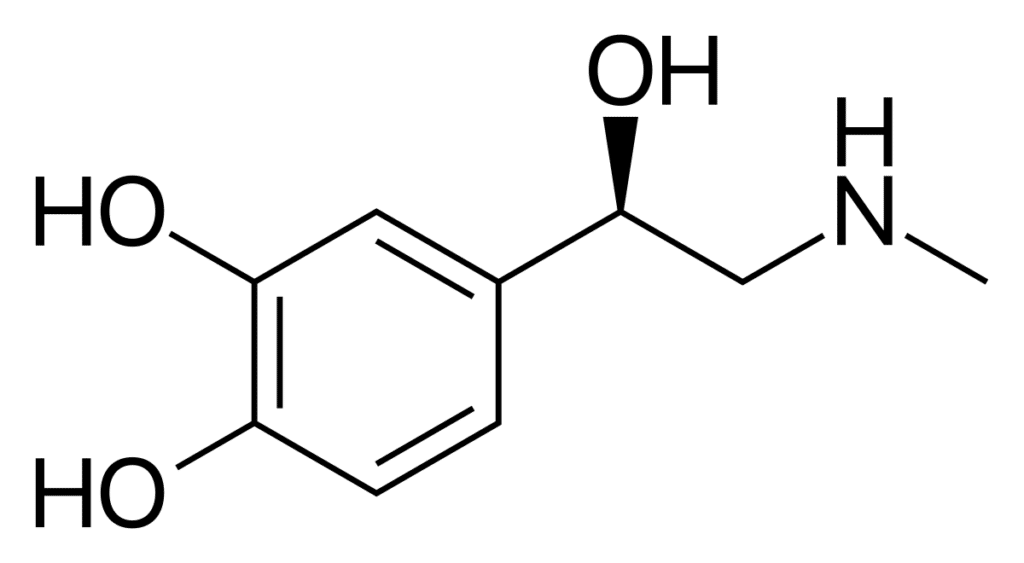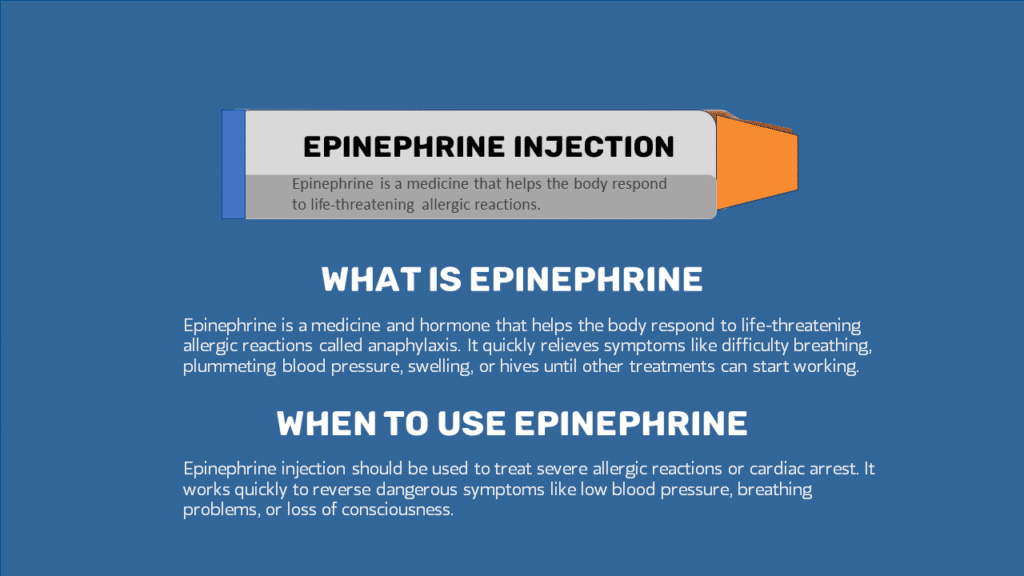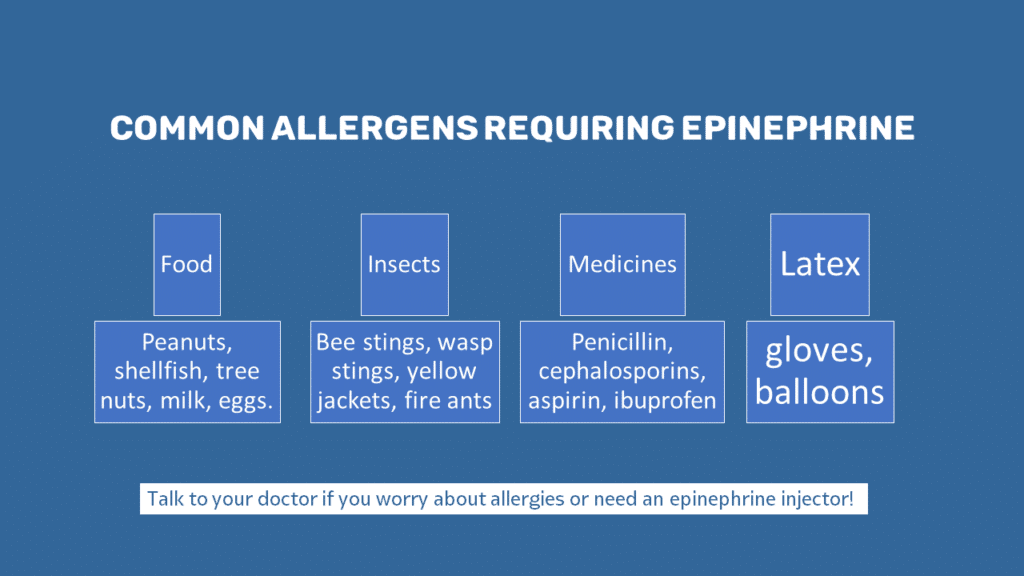Epinephrine Auto-injectors: Knowing How to Save Lives During Allergic Reaction.
Big allergic reactions (anaphylaxis) can be super dangerous if not fixed fast.
Devices like EpiPens give a quick shot of epinephrine medicine, helping until hospital care kicks in.
But questions come up about who can use them, how they work, how fast they help, and proper training.
This article explains the important things to know about these lifesaving tools.
Table of contents
- What is Epinephrine Auto-Injector?
- What are the Signs of Anaphylaxis in Children and Adults?
- Who Can administer Epinephrine Auto-Injector?
- What Happens with Epinephrine Auto-Injections?
- What Happens After an Epinephrine Shot?
- Where to Put the Shot on Your Legs?
- Are People Ever Allergic to Epinephrine?
- Why is training Important for Epinephrine Shots?
- More Things to Remember About Epinephrine Shots
- Closing Thoughts
- FAQs on Epinephrine

Adrenaline Image by: Wikipedia
What is Epinephrine Auto-Injector?
An epinephrine auto-injector is a special pen that shoots a medicine called adrenaline (also called epinephrine) into the thigh.
The medicine or hormone is important and helpful in saving lives during allergic reactions from things like food, bugs, or medicine. It works very fast and it is simple to use.

What Does Epinephrine Do?
Epinephrine is a medicine for serious allergic reactions.
It quickly helps with breathing problems, low blood pressure, swelling, or hives until other treatments start.
It’s the best emergency medicine for bad reactions to things like foods, insect stings, or medicines someone’s allergic to. It gives time to get more advanced hospital care.
What Does Epinephrine Do for Anaphylaxis?
When given for allergic shock, epinephrine has a few helpful effects:
- Opens up small breathing tubes for more air to pass through.
- Makes the heart pump harder, increasing blood pressure.
- Relaxes muscles in airways, reducing swelling.
- Reduces hives, rashes, and inflammation caused by the immune system.
Within 1-3 minutes, breathing should get easier, blood pressure should improve, and swelling should go down. The full effects show up in 5-15 minutes as the drug levels increase in the body.
When Should You Use an Epinephrine Injection?
You need emergency epinephrine for a likely allergy reaction if you see:
- Swollen lips or a tight throat making breathing very hard.
- Sudden widespread raised red rash or hives on the skin.
- Vomiting, diarrhea, or stomach cramps happening.
- Feelings of faintness, a racing heart, or a sense of “doom” reported.
- Collapsing, looking dizzy, or looking pale due to low blood pressure.
If you see one or more of these severe reaction signs – especially trouble breathing – think it’s a life-threatening situation needing epinephrine. Call for paramedic help right away.
What are the Signs of Anaphylaxis in Children and Adults?
Symptoms needing instant response include:
- Difficult, wheezing breathing
- Weakness, dizziness or fainting
- Lip/face/tongue swelling
- Raised spreading skin rashes
- Stomach issues – cramps, vomiting
The more body areas affected simultaneously, assume anaphylaxis until emergency care proves otherwise!
Tingling mouth or a few hives first does not mean full reaction yet. But observe closely in case it increases over time.

Who Can administer Epinephrine Auto-Injector?
Essentially, anyone can use an epinephrine auto-injector on a victim’s outer thigh during life-threatening allergic reactions.
EpiPens quickly shoot epinephrine medicine through the skin with a hidden needle, using a spring inside.
This fast medicine helps with anaphylactic reactions, like trouble breathing, low blood pressure, and swelling.
The devices are made simple for untrained people to use in emergencies.
Here’s who is advised to use them:
- The allergic person, if still able to follow simple instructions, can self-administer the medication.
- Friends, parents, coworkers, or bystanders witnessing an allergic reaction should quickly help with auto-injectors carried by the victim. Waiting risks losing medication effectiveness as symptoms get worse.
- Trained medical personnel, such as nurses and doctors, are instructed to use prescription epinephrine with formatted auto-injectors in standard anaphylaxis protocols.
Quick recognition and treatment save crucial minutes before paramedics arrive. Don’t hesitate to use available injectors!

What Happens with Epinephrine Auto-Injections?
Anti-allergy injectors, like EpiPens, allow delivering urgent doses of epinephrine medicine through an easy setup anyone can use, even when stressed.
Here are simple steps:
- Hold the injector in your fist with the orange needle removal tip pointing downward.
- Take off the blue activation safety cap with the opposite hand (Cap 1).
- Hold the black base flat against the middle of the outer thigh, then swing and firmly push the orange tip against the leg until the mechanism activates.
- Keep it firmly pressed to the skin for a full 10 count. The pen injects and then retracts the needle automatically.
- Remove the unit after hearing a ‘click’, showing completed dose administration. Massage the area for 10 seconds to circulate the medication.
- Note the time administered and keep the injector for hospital papers. Call emergency services and monitor the patient closely.
This general order gives a standard balanced epinephrine dose, quickly easing anaphylaxis processes until paramedics take over for higher-level care.
Most injectors also provide spoken directions when turned on.
How Fast Do Epinephrine Auto-Injections Work?
Expect noticeable relief in just 1-3 minutes after the injection, as epinephrine is quickly absorbed into the bloodstream from thigh muscles.
The maximum effects peak around 5-15 minutes after the dose, depending on age, metabolism rates, and absorption efficiency.
During this early stage, as epinephrine levels rise, vital developments like easier breathing, reduced skin rash/swelling, blood pressure recovery, and a return to normal mental status occur.
However, complete warning sign solution takes hours.
Auto-injectors aim to stabilize until hospital treatments fully restore balance.
Keep a close eye on the patient after injections, noting any ongoing distress.
Additional doses may be needed 20 minutes after the early use if breathing get worse, as epinephrine wears off while hospitals initiate improved care.
Following response shapes next decisions.
Book Today: Learn how to give medication and keep proper record – Get More Info
What Happens After an Epinephrine Shot?
Common but usually short-term effects of an epinephrine shot usually include:
- Pounding heart rate
- Shaking hands or nervousness
- Paleness initially then flushed skin later
More severe risks involve dangerously irregular heart rhythms, very high blood pressure levels, or worsening oxygen shortage reaching the brain if too much gets given incorrectly.
But serious effects remain very rare from proper emergency use.
Does Epinephrine Make Your Heart Beat Faster?
Yes! Epinephrine attaches to parts of your body that make your heart beat stronger and faster.
This helps when your blood pressure is low, but it also speeds up your heart in general.
This boost helps your body react quickly, but you might feel your heart pounding. Don’t worry, this is normal and goes away as the medicine leaves your body.
Doctors will keep checking you until you’re in good hands at the hospital.
Is Epinephrine Dangerous?
When used correctly for serious allergic reactions, it’s a lifesaver, and the risks are very low if you use it as instructed.
But using too much can make your heart beat and blood pressure dangerously high.
It’s only meant for temporary use until medical professionals can take over at the hospital to help your body get back to normal safely.

Where to Put the Shot on Your Legs?
To use the epinephrine injector right, put it in the middle of the outer part of your thigh.
This way, it goes into the thick muscles and works better.
Here’s how you do it:
- Look at the middle of your thighs when you’re standing, between your hip and knee.
- Move the injector about 3 finger widths above the middle towards the outer leg, not the inner thigh.
- Hold the unit straight without tilting the needle.
- Push it in straight through your clothes if you have to, making sure it touches your skin base.
Only put epinephrine in the front/center if you can’t get to the thigh. It works slower there.
But remember, always choose the middle of the outer thigh first!
Are People Ever Allergic to Epinephrine?
It’s rare to be truly allergic to Epinephrine.
But sometimes, people get stronger reactions if they get another dose too soon after the first one.
This can happen because the first dose hasn’t worn off yet, and adding another one builds it up in the body too quickly.
Using the right timing helps prevent this.
How Long Do Epinephrine Side Effects Last?
Most small side effects go away within 30 minutes as the medicine leaves your body.
But your heart might beat faster and you might feel shaky for 1-4 hours until everything settles down again.
Just relax and know that these effects are not for long.

Why is training Important for Epinephrine Shots?
Even though the injectors are easy to use, practicing with demo injectors really helps you get better at using them in a real emergency.
Doing it hands-on makes you automatic, so you don’t hesitate when things are intense and confusing.
Training helps in these important ways:
- Recognising Emergencies Faster: Knowing it’s a real emergency and you need epinephrine without wondering about milder symptoms first.
- Injecting Smoothly: Doing the steps quickly and smoothly to give the quickest relief.
- Thigh Pressure: Pressing on the thigh for 5-10 seconds right to keep the needle in until the full dose is given.
- Knowing the Time: Understanding how important it is to remember the exact time for future hospital care.
By practicing ahead of time, training makes it much more likely for things to go well during stressful situations.
It gives you confidence, muscle memory, and the right order of steps, saving important time during severe allergic reactions.
Join Today: Register For Our Anaphylaxis Training – See Full Course Content
What are the Main Benefits of Epinephrine Training?
Here are 5 big advantages that come after individuals, families, schools/camps, or workplace teams finish training with the auto-injector, protecting vulnerable groups:
- Makes people aware and confident in dealing with anaphylaxis emergencies.
- Allows practice of using the device for smooth administration.
- Reinforces the importance of marking injection times correctly for hospital care.
- Reduces the risk of mistakes and problems because proper use becomes a habit.
- Lowers the risk of lasting health problems or death through quick response.
Basically, training makes the urgent response faster, better, and more effective, maximizing the positive impact on life.
Everyone involved deals with shorter delays, less decision stress, and improved care skills, helping sick individuals precisely when minutes really matter. It saves lives!
More Things to Remember About Epinephrine Shots
Besides the main ideas about using it, here are a few more things to think about:
- Injectors expire after 12-24 months, depending on the medicine. Be aware and replace old ones in your kits.
- Check the dose if your child is growing, and allergies might get worse. The doctor may need to adjust it.
- Have an emergency plan that includes contacts and instructions after using the injector. This helps you be ready.
- Don’t use intravenous routes outside the hospital; it’s too risky.
- Remember, antihistamines like Benadryl don’t work well for severe allergies. Epinephrine injectors are important to stop certain symptoms. Keep two pens in your kits in case you need to use them again or if one doesn’t work well. They are a cheap way to have extra protection.
- These injectors are proven to help when you have a severe allergic reaction. They reduce the risk of a dangerous response in the nervous and immune systems, giving time to get more advanced help for a stable recovery.
Closing Thoughts
Anaphylaxis is a big problem that messes up how the body works, making it hard to breathe and affecting vital connections in the nervous system needed for life.
There aren’t many good options to fix these problems without advanced care.
But epinephrine auto-injectors, when quickly injected into thick tissues, give the best chance to bridge the short gap between almost failing to breathe and reaching the hospital in time.
This helps the hospital guardians bring back balance and monitor progress. When faced with the fear of death, having simple devices with strong power can be a practical lifesaver during a crisis.
Now that you know who injects, how it works, how fast it works, where to inject, the importance of training, and the value of being prepared – stay ready!
Being definitely prepared and acting calmly and swiftly when needed can make all the difference. Learn about auto-injectors now to be in control of future situations.
You have more influence over results than you might think. Use that power to save lives!
FAQs on Epinephrine
No, You don’t need a special certificate to use an EpiPen. The instructions are clear and easy to follow, so anyone can use it in an emergency.
But learning how to use one correctly is super important. Taking a training class can help you feel confident and avoid any mistakes when it matters most.
What’s the Difference Between Epinephrine and Adrenaline?
They’re actually the same thing! “Epinephrine” is the scientific name, while “adrenaline” is the more common term you might hear used in everyday life.
Both words describe the same helpful hormones and medicine that gets used to treat serious allergic reactions.
Why Did They Change the Name “Adrenaline” to “Ephinephrine”?
Originally, they called it “adrenaline,” but that word sometimes made people think about excitement or danger.
Later, experts learned more about the hormone and thought out how to use it as a medicine.
They wanted a new name that sounded more serious and scientific, so they renamed it “epinephrine.” But either way, it’s the same important stuff!
Yes, epinephrine is a hormone. Specifically, it is a stress hormone produced by the adrenal glands that plays an important role in the body’s “fight or flight” response to dangerous or stressful situations.
Let us Help you
We’ll help you find the right course for your needs. Tell us a little bit about your situation and what you would like to achieve.
We’ll get back to you within one working day.
